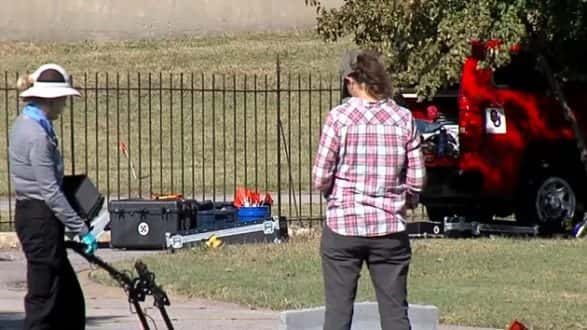
KTULBY: JENNY WAGNON COURTS
(TULSA, Oklahoma) — The city of Tulsa is breaking ground on a mission to find the truth. It’s a mission many agree is 99 years too late, but officials are beginning a journey to unearth a piece of the city’s history that many refused to speak openly about until recently.
A team of professional historians, forensic anthropologists and archaeologists is digging up ground at Oaklawn Cemetery in search of victims of the 1921 Tulsa Race Massacre.
What began as a confrontation between groups of white and black residents following the arrest of a young black man named Dick Rowland ended with 35 city blocks being burned to the ground in the city’s Greenwood District. Greenwood was an affluent area known as Black Wall Street, and home to 1,200 black residents and 300 black-owned businesses.
Rowland was riding in an elevator with a white woman named Sarah Page. Details about what happened in the elevator have never been confirmed, but reports say Page screamed and Rowland ran off. According to official reports on the event, Tulsa Police arrested Rowland the next day.
An article published in the local paper led members of the black community to believe Rowland would be lynched, so a group of black residents went to the courthouse where Rowland was being held, where they were confronted by a group of white residents. Shots were fired, witnesses interviewed in the weeks and months following the event said, but as black residents returned to Greenwood, they were followed by white mobs, who opened fire on black residents and began looting and setting fire to buildings.
The case against Dick Rowland was dismissed in September 1921.
Historians believe that as many as 300 people were killed as white mobs destroyed homes, businesses, churches, schools, hospitals and other buildings over a span of two days. Nearly 100 years later, many of those victims’ bodies have never been found.
“Step one that took 99 years to get here but that’s where we are,” said Mayor G.T. Bynum, who has made this project a personal mission. “The ultimate goal here is to connect the victims of this event with their family and that is an ambitious goal and an incredible challenge.”
Plans to begin the search with a test excavation were set to begin in April but were postponed because of the coronavirus pandemic. As crews gathered Monday morning, the weather caused an additional delay, this time just a few hours. A small crowd of onlookers and media gathered to watch as the work began on what Oklahoma State archaeologist Kary Stackelbeck says is the start of what will be an ongoing process.
“This is an intermediate step intended to open a small window in that larger anomaly to see if there are actually human remains,” she said. If evidence of a mass grave is found, the excavation will continue.
For forensic anthropologist Phoebe Stubblefield, the search is the culmination of 22 years of work. She is a member of the original investigation team that started gathering data and information in 1999. “It’s not closure, but you are providing a peace to what happened and who these people are.”
Stubblefield, who is with the University of Florida, is among those who will carefully watch each piece of soil removed from the cemetery. Her job is to inspect any remains that may be found for signs of trauma. It’s a painstaking process. If remains are found, Stubblefied will also begin to try and trace their ancestry. “After 100 years often the only good DNA available may be the DNA that speaks to your maternal family line,” she told ABC News at a news conference.
The excavation team will work at the cemetery for approximately the next six days, but off-sight this work could take years. Oaklawn is one of three sites officials in Tulsa identified as possible locations of mass graves.
Descendants of the victims are living all across the world. For many, what led to potential mass graves in Tulsa is a story told through generations; for others it’s a story they tried to forget. Mayor Bynum says this part of the city’s history has long remained hidden due to the reluctance to revisit those dark days. “The conspiracy of silence was strong enough we had generations grow up here who didn’t know about it,” he said.
In an effort to help educate more people about the massacre and the new efforts underway, the city is providing a live stream of the excavation site and posting updates on social media. Bynum says the goal is to make sure the story of what happened in Tulsa in 1921 is no longer passed down as generational folklore.
“It reflects very poorly on Tulsa in 1921. It only reflects poorly on Tulsa in 2020 if we continue to try and cover it up and not talk about rather than pursuing the truth. We’re going to follow the truth on this wherever it takes us. And the first step is to try and identify the location of those remains.”
Copyright © 2020, ABC Audio. All rights reserved.










